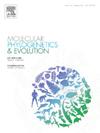Evolutionary insights from the pangenome and pigment profiles of Parasynechococcus
IF 3.6
1区 生物学
Q2 BIOCHEMISTRY & MOLECULAR BIOLOGY
引用次数: 0
Abstract
Parasynechococcus is one of the two essential alongside Prochlorococcus photosynthetic cyanobacteria that contribute primary productivity in the ocean. Despite its global importance its specie delimitation remains controversial. Herein, a pangenome analysis of 39 high-quality genomes was conducted to delineate Parasynechococcus species. Core-gene phylogram revealed the classification of these genomes into 18 well-defined putative genospecies, which was corroborated by ANI index and GTDB classification. Moreover, numerous interspecies and intraspecies HGT events were detected, some of which may be responsible for the inconsistencies between core-gene and pan-gene phylograms. Besides, the profiling of phycobilisome rod region in Parasynechococcus genomes unraveled intriguing diversity of their genomic organization, pigment type and genomic cluster variants. The diversification process was hypothesized to be mediated by the putative mobile elements located in these regions. Moreover, phylogeny incongruence between the genes within phycobilisome rod region and the core genome indicate distinct evolutionary history, which could be ascribed to lateral gene transfer. Conclusively, the results provide insights into the diversity and evolution of Parasynechococcus from the perspective of pangenome and pigment type, facilitating the evolutionary research and exploration of this important taxon.

从副葡萄球菌泛基因组和色素谱的进化见解。
副葡萄球菌是与原绿球藻一起贡献海洋初级生产力的两种重要光合蓝藻之一。尽管其在全球具有重要意义,但其物种划分仍存在争议。本文对39个高质量基因组进行了全基因组分析,以确定副葡萄球菌的种类。核心基因系统图谱显示这些基因组可划分为18个明确的推定基因种,ANI指数和GTDB分类证实了这一点。此外,还检测到许多种间和种内HGT事件,其中一些事件可能导致核心基因和泛基因系统图谱之间的不一致。此外,对副葡萄球菌基因组中藻胆体棒状区域的分析揭示了其基因组组织、色素类型和基因组簇变异的有趣多样性。多样化过程被假设是由位于这些区域的假定的可移动元素介导的。此外,藻胆体棒区基因与核心基因组的系统发育不一致表明了不同的进化史,这可能归因于基因的横向转移。综上所述,这些结果从泛基因组和色素类型的角度深入了解了副葡萄球菌的多样性和进化,为这一重要分类群的进化研究和探索提供了便利。
本文章由计算机程序翻译,如有差异,请以英文原文为准。
求助全文
约1分钟内获得全文
求助全文
来源期刊
CiteScore
7.50
自引率
7.30%
发文量
249
审稿时长
7.5 months
期刊介绍:
Molecular Phylogenetics and Evolution is dedicated to bringing Darwin''s dream within grasp - to "have fairly true genealogical trees of each great kingdom of Nature." The journal provides a forum for molecular studies that advance our understanding of phylogeny and evolution, further the development of phylogenetically more accurate taxonomic classifications, and ultimately bring a unified classification for all the ramifying lines of life. Phylogeographic studies will be considered for publication if they offer EXCEPTIONAL theoretical or empirical advances.

 求助内容:
求助内容: 应助结果提醒方式:
应助结果提醒方式:


